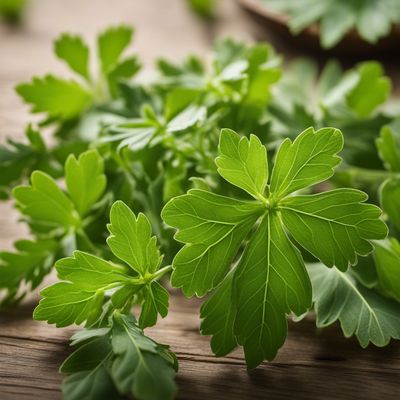
Ingredient
Angelica, dry
The Heavenly Herb: Unveiling the Secrets of Dry Angelica
Dry angelica, derived from the Angelica archangelica plant, is a herbaceous perennial known for its tall stalks, feathery leaves, and clusters of small greenish-white flowers. The dried form of angelica possesses a distinct aroma, reminiscent of musk and juniper, and a flavor profile that is both bitter and sweet. Its texture is fibrous and slightly chewy, adding a unique element to dishes.
Origins and history
Angelica has a long history dating back to ancient times, where it was revered for its medicinal properties and believed to have been a gift from the archangel Michael. Native to northern Europe and Asia, it was widely used by the Vikings, who believed it could ward off evil spirits and protect against the plague. Over time, angelica became a popular ingredient in liqueurs, confectionery, and traditional herbal remedies.
Nutritional information
Dry angelica is a good source of vitamins A and C, as well as minerals like potassium and calcium. It is low in calories, with approximately 50 calories per 100 grams.
Allergens
There are no known allergens associated with dry angelica.
How to select
When selecting dry angelica, look for tightly sealed packaging to ensure freshness. Check for any signs of moisture or clumping, as this may indicate poor quality. Opt for organic or sustainably sourced options whenever possible.
Storage recommendations
To maintain the freshness and quality of dry angelica, store it in an airtight container in a cool, dark place away from direct sunlight. Properly stored, it can retain its flavor and aroma for up to one year.
How to produce
Growing angelica requires a cool climate and moist soil. It can be cultivated from seeds or propagated through root cuttings. However, due to its specific growing conditions and long maturity period, it is best left to experienced gardeners or commercial producers.
Preparation tips
Dry angelica can be used in various culinary applications. It is commonly infused in spirits, such as gin or vermouth, to add a unique herbal note. It can also be used in baking, particularly in traditional European sweets like cakes, cookies, and candies. Additionally, it can be steeped in hot water to make a fragrant herbal tea. Remember to use it sparingly, as its strong flavor can easily overpower other ingredients.
Culinary uses
Dry angelica is widely used in traditional Scandinavian cuisine, where it is incorporated into dishes like gravlax (cured salmon), aquavit (herbal spirit), and various desserts. It is also a key ingredient in certain Belgian beers and liqueurs, adding complexity and depth to their flavor profiles.
Availability
Dry angelica is commonly available in regions where it is cultivated, such as northern Europe and parts of Asia. It can also be found in specialty stores or online retailers that offer a wide range of culinary herbs and ingredients.
More ingredients from this category » Browse all

Wormwoods, dry
The Bitter Herb: Wormwoods

Sweet cicely, dry
The Delicate Herb: Sweet Cicely

Bay leaves, dry
Aromatic Leaf of Flavor

Basil, dry
The Fragrant Herb: Dried Basil

Thyme, dry
The Essence of Thyme: A Versatile Herb

Savory, dry
Umami Delight

Celery leaves, dry
The Flavorful Herb: Dry Celery Leaves

Lavender, dry
The Fragrant Herb: Lavender

Sage, dry
The Timeless Herb: Unveiling the Versatility of Dry Sage

Lovage, dry
The Aromatic Herb: Lovage

Fennel, dry
The Fragrant Spice of the Mediterranean

Wintergreen leaves, dry
Nature's Minty Delight